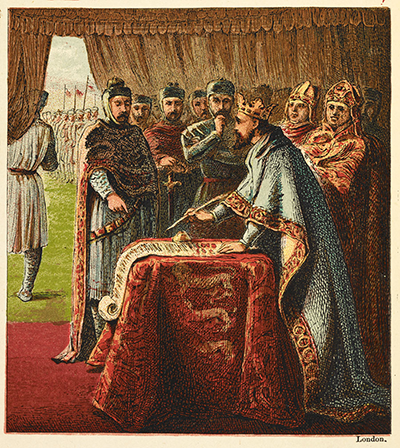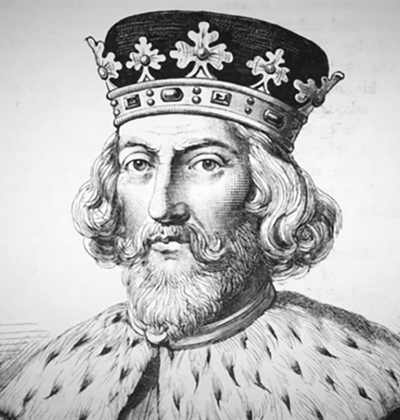



King John Ė Quick Stats




Born: December 24, 1166
King John of England: The Tyrant, the Rebel Barons, and the Birth of Magna Carta
King John of England (1166Ė1216) remains one of the most controversial and debated monarchs in English history. Known for his disputes with the nobility, his conflicts with the Church, and his role in the sealing of Magna Carta, Johnís reign was marked by turmoil, rebellion, and military failures.
Early Life and Rise to the Throne
John was born on December 24, 1166, at Beaumont Palace in Oxford, the youngest son of King Henry II and Eleanor of Aquitaine. As the youngest of five brothers, he was not expected to inherit significant power, earning him the nickname "John Lackland." However, after the deaths of his older brothers, he became a key player in the succession crisis following the death of his father in 1189.
John was born on December 24, 1166, at Beaumont Palace in Oxford, the youngest son of King Henry II and Eleanor of Aquitaine. As the youngest of five brothers, he was not expected to inherit significant power, earning him the nickname "John Lackland." However, after the deaths of his older brothers, he became a key player in the succession crisis following the death of his father in 1189.
Initially, John was overshadowed by his older brother, Richard I (the Lionheart). Richard granted John several lands and titles but forbade him from ruling England in his absence during the Third Crusade. However, John conspired against Richardís appointed regents and attempted to claim power, leading to distrust between the brothers. When Richard died in 1199, John successfully claimed the English throne despite challenges from his nephew, Arthur of Brittany.
John was officially crowned king in Westminster Abbey on May 27, 1199. His claim was contested by Arthur, supported by the French King Philip II, who sought to exploit Englandís internal strife. Johnís diplomatic skills initially allowed him to secure peace, but his harsh rule and military failures soon led to renewed conflict.
Magna Carta and Rebellion
Johnís heavy taxation and arbitrary rule led to widespread rebellion among the English barons. In 1215, facing mounting pressure, he was forced to negotiate with the barons and agreed to the terms of Magna Carta, a document that limited royal power and established certain legal protections for the nobility. Although John sealed Magna Carta at Runnymede, he almost immediately sought to annul it, leading to the First Baronsí War.
Johnís heavy taxation and arbitrary rule led to widespread rebellion among the English barons. In 1215, facing mounting pressure, he was forced to negotiate with the barons and agreed to the terms of Magna Carta, a document that limited royal power and established certain legal protections for the nobility. Although John sealed Magna Carta at Runnymede, he almost immediately sought to annul it, leading to the First Baronsí War.
As the war progressed, John suffered a major setback when he lost his treasure and supplies in quicksand while crossing the Wash in eastern England. This disaster, combined with his worsening health, significantly weakened his position. His final months were marked by desperate attempts to rally his remaining forces, but his death in October 1216 at Newark Castle changed the course of the conflict.
Johnís military struggles in France culminated in the loss of Normandy in 1204, a devastating blow to English power on the continent. This loss weakened his authority among the nobility, who grew increasingly frustrated with his high taxation and military failures. His inability to reclaim these lands left him at odds with both the barons and the French crown, contributing to ongoing instability throughout his reign.
Conflict with the Church
Another major conflict of Johnís reign was his dispute with Pope Innocent III over the appointment of the Archbishop of Canterbury. John refused to accept the Popeís candidate, Stephen Langton, leading to England being placed under an interdict in 1208 and Johnís excommunication in 1209. This dispute weakened his position further, and in 1213, John was forced to submit to the Pope, effectively making England a papal vassal state. This surrender granted him papal protection but further alienated his barons.
Another major conflict of Johnís reign was his dispute with Pope Innocent III over the appointment of the Archbishop of Canterbury. John refused to accept the Popeís candidate, Stephen Langton, leading to England being placed under an interdict in 1208 and Johnís excommunication in 1209. This dispute weakened his position further, and in 1213, John was forced to submit to the Pope, effectively making England a papal vassal state. This surrender granted him papal protection but further alienated his barons.
Died: October 19, 1216
Mother: Eleanor of Aquitaine
Father: King Henry II of England
Wives:
Children:
The First Baronsí War and Civil War
Johnís rejection of Magna Carta plunged England into civil war, known as the First Baronsí War (1215Ė1217). The rebel barons, frustrated with Johnís refusal to adhere to the charterís terms, sought aid from Prince Louis of France, who invaded England in 1216. Louis quickly gained control of London and much of the southeast, with many English nobles swearing allegiance to him.
Johnís rejection of Magna Carta plunged England into civil war, known as the First Baronsí War (1215Ė1217). The rebel barons, frustrated with Johnís refusal to adhere to the charterís terms, sought aid from Prince Louis of France, who invaded England in 1216. Louis quickly gained control of London and much of the southeast, with many English nobles swearing allegiance to him.
King John Signing the Magna Carta
Isabella of Gloucester (m. 1189, annulled 1199)
Isabella of AngoulÍme (m. 1200)
Henry III of England
Richard, 1st Earl of Cornwall
Eleanor, Countess of Pembroke
Isabella, Holy Roman Empress
Joan, Queen of Scotland
Successor: Henry III
Predecessor: King Richard I The Lionheart
Despite his negative historical reputation, his reign had a lasting impact on Englandís legal and political systems. His complex character and tumultuous rule continue to be widely studied, revealing a monarch whose missteps inadvertently paved the way for constitutional developments that shaped the future of governance in England.
Reign and Conflicts
Johnís reign (1199Ė1216) was characterized by internal and external conflicts. His first major challenge was securing his position against Arthur, who had the backing of King Philip II of France. John captured Arthur in 1202, and his mysterious disappearanceówidely believed to be murder on Johnís ordersóled to significant opposition against John in France.
Johnís reign (1199Ė1216) was characterized by internal and external conflicts. His first major challenge was securing his position against Arthur, who had the backing of King Philip II of France. John captured Arthur in 1202, and his mysterious disappearanceówidely believed to be murder on Johnís ordersóled to significant opposition against John in France.

Johnís forces, though weakened, continued to resist. He relied on loyalist commanders such as William Marshal, one of the most respected knights of the era. However, John's campaign was hindered by his increasing unpopularity, dwindling resources, and shifting loyalties among the English nobility.
Following Johnís death, his nine-year-old son, Henry III, was crowned, and the regents governing on his behalf, led by William Marshal, reissued Magna Carta to regain the support of the barons. Over the next year, Marshal led a successful military campaign, defeating the French and rebel forces at the Battle of Lincoln in 1217. The Treaty of Lambeth later in 1217 formally ended the war, with Prince Louis renouncing his claim to the English throne and withdrawing his forces. This victory reaffirmed English sovereignty and paved the way for a period of relative stability.
Death and Legacy
John died on October 19, 1216, likely from dysentery, at Newark Castle. His son, Henry III, succeeded him, and the reissuance of Magna Carta under his regents helped restore stability to England.
John died on October 19, 1216, likely from dysentery, at Newark Castle. His son, Henry III, succeeded him, and the reissuance of Magna Carta under his regents helped restore stability to England.
King Johnís reign is often remembered for his failures, including military losses, disputes with the nobility and clergy, and his ruthless policies. However, his reign played a crucial role in shaping the evolution of constitutional governance in England. Magna Carta, though originally a feudal document, laid the foundation for the development of parliamentary democracy and the rule of law in later centuries.
Despite his troubled legacy, John remains a fascinating figure whose reign significantly influenced English history. His portrayal in literature and folklore, often as a villain in Robin Hood legends, reflects the enduring impact of his rule on popular culture. His policies, both oppressive and reformative, shaped the English monarchyís future, reinforcing the balance of power between the crown and its subjects.
In hindsight, Johnís reign can be seen as a turning point in medieval English history. While he failed as a military leader and struggled to maintain the loyalty of his nobles, his reign inadvertently laid the groundwork for legal and governmental evolution. The principles set forth in Magna Carta continued to inspire movements advocating for civil liberties and democratic governance, ensuring Johnís influence persisted far beyond his lifetime.



